My phone rang recently, and it was Betsy Baker, the long-time Editor-in-Chief of Art in America and also an old friend of mine, although we are not much in touch these days. She was checking in to see how I was doing after the Virginia Tech shootings, and she wanted to know, was I writing anything these days?
I've got a blog, I told her, and that's pretty much it. I wrote something about the massacre. Then she asked if any of my blogs were about art?
"Ay-yi-yi, no!" Not so far anyway.
Then I got this catalogue in the mail. It listed all the art and technology books scheduled for publication by MIT Press in 2007. I immediately checked it out to see what writers who ARE writing about art are doing. I opened the catalogue at random and my eye landed on a book called "History of Shit" by Dominique Laporte. (I kid you not.)
Whoa! I thought. Here comes my next blog.
"I'm on it," says Virgil, my indefatiguable alligator blogging assistant, his arms windmilling like crazy. The book was listed in the section called Cultural Studies, and the blurb went something like this:
"'History of Shit' suggests...that the management of human waste is crucial to our identities as modern individuals--including the organization of the city, the rise of the nation-state, the development of capitalism, and the mandate for clean and proper language. Far from rising above the muck, Laporte argues, we are thoroughly mired in it, particularly when we appear our most clean and hygienic."
Whatever.
Virgil and I then flipped over to the Art section, where we found a book entitled "Chronophobia: On Time in the Art of the 1960s" by Pamela Lee. The term is one coined by the author to refer to the anxiety and uneasiness about time, embodied in works ranging from kinetic sculptures to Andy Warhol's films. This topic, according to the author, has gone largely unexamined in historical accounts of the period.
How could this happen?
Since good things supposedly come in three's, we decided to choose one more book. Virgil picked his favorite from a section headed Design: "The Aesthetics of the Japanese Lunchbox" by Kenji Ekuan.
The Makunouchi Bento, or traditional Japanese lunch box, is a lacquered wooden box divided into quadrants, each of which contains different delicacies. (Virgil is smacking his lips with pleasure.) The author's thesis is that the lunchbox is a key to understanding the whole of Japanese civilization, from food to television to motorcyles, package tours, landscape, and computers.
"All this sharp writing really gives your brain cuts," says Virgil, mischievously waving his cup of dandelion wine. "Remember Jimmy Durante? How he liked to say 'It's duh toast of duh intellectuals?'" Virgil ostentatiously swigs down the last of his dandelion wine.
"Cheers!" he says, looking positively seraphic in his concentration.
I haven't even mentioned the book with the most intriguing title: "How to See a Work of Art in Total Darkness." In case you are wondering what it's about, it deals with issues of black artists necessarily being viewed in terms of their "blackness," and not really liking it any more. I'm thinking Virgil should apply for a top-level editorial position at MIT Press, don't you?
Sunday, June 3, 2007
Subscribe to:
Post Comments (Atom)

3 comments:
I guess it takes an artist to come up with such creative titles that intrigue you enough to make you take notice!
Oh Sooze you are not making a link between contemporary art and shit are you? Maybe I am looking for too many synchronicities or maybe I am just paranoid. Being the result of a contemporary art project (bimboborg.org) I feel a little uncomfortable at the closeness of association. However one does not have organic waste in cyber space and if I did it would not smell.
But when was the last time anyone cited Suzi Gablik's writing in a serious work of...anything?
Post a Comment